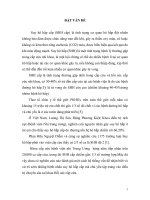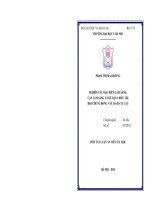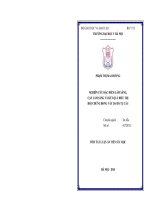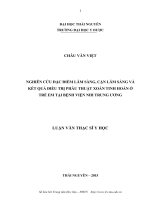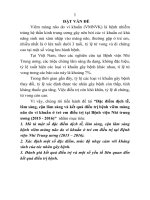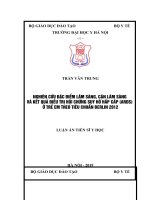Nghiên cứu đặc điểm lâm sàng, cận lâm sàng và kết quả điều trị hội chứng suy hô hấp cấp (ARDS) ở trẻ em theo tiêu chuẩn berlin 2012 tt tiếng anh
Bạn đang xem bản rút gọn của tài liệu. Xem và tải ngay bản đầy đủ của tài liệu tại đây (345.31 KB, 30 trang )
MINISTRY OF EDUCATION AND TRAINING
MINISTRY OF HEALTH
HANOI MEDICAL UNIVERSITY
TRAN VAN TRUNG
RESEARCH CLINICAL, SUBCLINICAL CHARACTERISTICS AND
TREATMENT RESULTS OF ARDS IN CHILDREN
ACCORDING TO BERLIN 2012.
Major: Pediatrics
Code: 62720135
SUMMARY OF DOCTORAL DISSERTATION IN MEDICINE
HANOI - 2019
THE WORK COMPLETED IN HANOI MEDICAL UNIVERSITY
Scientific Supervisor:
ASSO.PROF.DR. PHAM VAN THANG
Opponent 1:
Opponent 2:
Opponent 3:
The dissertation is presented in front of the Board of Examiners –
University level held in Hanoi Medical University.
At ................on..................... 2019.
Dissertation may be seen at:
- National Library of Vietnam
- Library of Hanoi Medical University
LIST OF RESEARCHES IN RELATION TO THE
DISSERTATION
1. Tran Van Trung, Pham Van Thang (2017). Some epidemiological
- clinical characteristics and cause of ARDS in children according to
Berlin 2012. Pediatrics Journal, 10 (6): 5 – 9.
2. Tran Van Trung, Pham Van Thang (2017). Treatment outcomes
and some factors relating to treatment outcomes of ARDS in
children. Pediatrics Journal, 10 (3): 13 – 19.
4
PREAMBLE
Acute Respiratory Distress Syndrome (ARDS) is serious and critical
disease condition in the intensive care departments, occurring in both
adults and children. Although Although there has been much progress in
intensive car for ARDS patients so far mortality rate of this disease is still
high that is 40-60%. Vietnam is a developing country, the rate of children
with bacterial or viral respiratory infections, septic shock, poisoning,
drowning ... is at high risk of developing ARDS.
Previously, ARDS diagnosis was based on AECC 1994. In 2012, a new
diagnostic standard for ARDS, called Berlin 2012 was published. This
standard is considered to be simpler, easier to apply, allowing for early
diagnosis and different levels of severity of ARDS, which helps to have
better prognosis. Therefore, if the Berlin 2012 is used, it is possible to help
the pediatricians, especially in the lower levels, to identify and classify
ARDS patients according to their severity in order to solve it in timely
manner with the right method resulting in reducing the mortality rate of this
disease. In Vietnam, no systematic study has been conducted to assess the
clinical and subclinical characteristics of ARDS and its treatment results in
children recommended by the Berlin 2012 Conference.
As a result, we have researched: “Research clinical and subclinical
characteristics and treatment results of ARDS in children according to
Berlin 2012” with following objectives:
1. Describe clinical and subclinical characteristics of ARDS in children
according to Berlin 2012.
2. Comments on treatment results of ARDS in children as recommended
by Berlin 2012.
3. Identify some factors associated with the mortality ratio of ARDS in
children.
5
1. Rationale of the research
ARDS in children is a serious disease in the intensive care
departments with very high mortality rate. The new
diagnostic standard for ARDS published in 2012 is
evaluated as simple, easy to apply, allowing early
diagnosis with different levels of severity, which help to
have better prognosis. Therefore, a systematic study of
clinical, subclinical characteristics and mortality-related
factors of ARDS in children according to the Berlin 2012
may help pediatricians, especially those in lower level, to
early identify and classify ARDS patients according to their
severity in order to solve it in timely manner with the right
method resulting in reducing the mortality rate of this
disease.
2. New contributions of the dissertation
The dissertation is the first systematic study on ARDS in children
according to Berlin 2012. The dissertation has identified the clinical and
subclinical characteristics of ARDS patients treated in the intensive care
departments of Vietnam National Children Hospital at the average age of
15.8 ± 26.5 months, with 45% at serious level, 92% of the cases due to lung
causes, mainly viral pneumonia, especially related to measles. Regarding
treatment: despite intensive care with modern facilities the mortality rate is
still very high (58.2%). Mortality rate depends on the severity of the disease:
from 27.3% in mild to 81.8% in severe form. Most deaths occur during the
first week of illness. The rate of hospital infection is 28.6%. The factors
related to mortality of ARDS by multiple regression analysis include: origin
related to measles, pre-treatment indicatoprs PaO2 ≤ 80mmHg, P/E ≤ 100;
S/F ≤ 117, OI > 18,5 and OSI > 15, with mmultiple organ failure.
Oxygen index (OI) and oxygen saturation index (OSI) found during
treatment process may help predict the risk of death in ARDS patients.
3. Structure of the dissertation
The dissertation consists of 122 pages. In addition to the preamble (3
pages), the conclusion (2 pages) and the recommendation (1 page) it has 4
chapters including: Chapter 1: Overview with 34 pages; Chapter 2: Object
and research method with 16 pages; Chapter 3: Research results with 34
pages; Chapter 4: Discussion with 32 pages. The dissertation consists of 37
6
tables, 2 diagrams, 4 figures, 10 charts, 160 documents of reference
(Vietnamese: 8; English: 152).
Chapter 1
OVERVIEW
1.1.
Concept and criteria of diagnosis
ARDS was first described in 1967 by Ashbaugh with the
characteristics: acute respiratory failure after a lung injury or a injury in
other organ, the patient has severe hypoxemia, poor response to
conventional ventilation measures, chest radiograph images showed diffuse
alveolar damage in both sides of the lung, rapid evolution between the times
of radiography. However, in 1994, at the American-European Consensus
Conference (AECC) on ARDS, the specific diagnostic criteria for this
syndrome were given.
Table 1.1. AECC 1994
In 2012, a new diagnostic criterion for ARDS called Berlin 2012
(Table 1.2) was published to replace the criterion in 1994. This new
criterion was assessed as more specific, enabling early diagnosis and the
severity levels are classified resulting in better prognosis and may be
applied to children.
Table 1.2. Berlin 2012 Criterion
Acute onset within 01 week with new or more seriou
Onset
symptoms.
Bilateral opacities on chest X-ray which were not fully
Chest X-ray
effusions, lung collapse or nodules.
Respiratory failure not caused by cardiac failure or flu
Cause of respiratory
Echo-cardiography, if needed, to rule out cardiogenic
failure
edema.
Hypoxemia
PaO2/FiO2 ≤ 300 with PEEP or CPAP ≥ 5cmH2O
Classification
+ Mild: 200 < PaO2/FiO2 ≤ 300
+ Moderate: 100 < PaO2/FiO2 ≤ 200
7
+ Severe: PaO2/FiO2 ≤ 100
1.2.
Cause of ARDS in children
ARDS may be triggered after a direct injury to lung parenchyma
or by an indirect system-derived agent causing lung damage through
pulmonary circulation. In children, lung-related causes are mainly
bacterial or viral pneumonia and non-pulmonary causes are mainly
shock, especially septic shock.
1.3.
Clinical and subclinical characteristics of ARDS
- The clinical course of ARDS usually undergoes 3 stages: onset, full
development and recovery. Onset symptoms are usually nonspecific and
marked by the signs of new respiratory symptoms such as dyspnea, rapid
breathing, respiratory muscle retractions, moist rales lung sounds may be
heard with bilateral infiltrates on X-ray film. Full development stage
usually lasts within 1 to 2 weeks depending on each patient. In this stage,
most ARDS patients have severe hypoxia and need oxygen or mechanical
ventilation. Clinically recognizable signs include: the patient looks pale
gray, reduction of SpO2 and needs more oxygen to breath (FiO2). Other
indicators help further assess the patient's hypoxia such as PaO2, PaO2 /
FiO2 ratio, oxygen index (OI). Patients also have signs of multiple organ
dysfunction, acid-base disorder as a result of respiratory failure. The patients
who go through the full development will move to the stage of fibrosis and
recovery. Full recovery depends much on the level of pulmonary fibrosis
and its complications
-In the subclinical tests, arterial blood gas usually has severe
hypoxemia: SaO2 and PaO2 are often low, the oxygen pressure
difference between the alveolus and artery (DO2) increases. The injury
image on the X-ray of ARDS is the alveolar lesions and interstitial
spaces, spreading to both sides and evolving rapidly. Other tests such as
blood counts, electrolytes, liver and kidney function, coagulation tests
are usually not specific to help assess the cause or complication of
ARDS or homeostasis of the patients.
1.4.
Treatment of ARDS
8
The most basic and important treatment for ARDS patients is still
mechanical ventilation. The goal of ventilation for ARDS patients is to
maintain adequate oxidation and ventilation levels, limiting the impact from
mechanical ventilation. There have been many strategies, methods and
mechanical ventilation procedures mentioned and studied such as:
mechanical ventilation with positive end-expiratory pressure (PEEP), lung
protective ventilation with low tidal volume (Vt), mechanical ventilation by
lung opening strategy, high frequency oscillatory ventilation, prone
ventilation ... some of which have been proved to improve blood oxidation
and reduction of mortality ratio caused by ARDS
As recommended by Berlin 2012 Conference, lung protective
ventilation with low tidal volume (Vt) in combination with PEEP remains
the primary ventilation method for ARDS patients. High high frequency
oscillatory ventilation (HFO) and prone ventilation are indicated for severe
ARDS patients and unsuccessful with conventional ventilation methods.
Muscle relaxants are considered for the severe ARDS patients. Other
conventional treatments are to support the damaged lung, improve
homeostasis, support multi-organ function and reduce mortality.
1.5.
Some factors relating to mortality in children caused by ARDS
There have been many studies in the factors associated with
mortality of ARDS patients to help clinicians better make prognosis of the
patients. The studies focused on a number of factors such as the severity of
ARDS patients at the time of diagnosis, host factor and underlying disease
of the patient, response to treatment and complications during treatment
process. The factors assessing the severity of patients include: degree of
hypoxia (assessed by the SpO2, PaO2 blood index, PaO2 / FiO2 ratio, OI
index ...), initial ventilation parameters and FiO2 demand, multi-organ
failure status of patients ... Special host factors and underlying diseases of
the patient such as history of severe illness or the presence of one or more
underlying diseases such as immunodeficiency diseases, congenital
metabolic disorders ... accidents or complications during the course of
treatment such as: complications due to ventilation (pneumothorax,
pneumomediastinum), gastrointestinal hemorrhage, hospital infection ...
9
10
Chapter 2
OBJECT AND RESEARCH METHOD
2.1. Object of the research
98 patients at the age of 1 month - 15 year old,
hospitalized into Intensive care department – Vietnam
National Children Hospital, diagnosed ARDS and treated
from 01/2014 to 7/2016.
- Criteria for ARDS diagnosis and classification: applying Berlin
2012
Onset of respiratory failure within 01 week, new/more
serious symptoms appear.
Lung X-ray: Bilateral opacities on chest X-ray which were not fully
explained by effusions, lung collapse or nodules.
Respiratory failure not caused by cardiac failure or fluid overload.
Echo-cardiography, if needed, to rule out cardiogenic pulmonary
edema.
Hypoxemia: PaO2/FiO2 ≤ 300 với PEEP/CPAP ≥ 5cmH2O.
Mild
ARDS: 200 < PaO2/FiO2 ≤ 300 with PEEP/CPAP ≥
5cmH2O.
Moderate ARDS: 100 < PaO2/FiO2 ≤ 200 with PEEP ≥
5cmH2O.
Severe ARDS: PaO2/FiO2 ≤ 100 with PEEP ≥ 5cmH2O.
- Exclusions
ARDS patients who have suffered the disease more
than 7 days before hospitalization.
ARDS patients died quickly (< 2 hours) after
hospitalization.
ARDS patients have congenital cardiac disease with
pale gray.
2.2. Research methods
Research
design:
Descriptive
prospective study,
interventional non-control treatment.
Sampling method:
- Objective 1: Total selection.
- Objective 2 and 3: using the formula for calculating
11
sample size in the research to determine: n = Z 2 1 -α/2 x
p(1-p)/δ2, where α=0,05 and Z1 -α/2 =1,96; p = 0,63 is
the mortality ratio of ARDS in children according to a
research carried out in 2012 by Phan Huu Phuc; δ = 0,1
is an allowable tolerance. The minimum sample size
calculated with the formula is 89 patients.
- Objective 3: using the formula for calculating sample
size in the research to Identify some factors associated
with the mortality ratio.
Content and variances of the research:
- Some general characteristics of the objects researched: age, gender,
weight, living location, medical history, special
underlying disease /host factor of the patients.
- Clinical characteristics of ARDS in children:
+ Onset of ARDS in children: time, characteristics and
cause of onset.
+ State of respiratory failure: Need of mechanical
ventilation (using ventilator with the indicators FiO2, PIP,
PEEP, MAP, breathing rate), hypoxemia level is
determined with the indicator: SpO2, PaO2, oxygen index
(OI = (MAP x FiO2 x 100)/PaO2).
+ Hemodynamic characteristic: heart rate, blood
pressure, vasopressors.
+ Followed by multiple organ failure.
- Subclinical characteristics of ARDS in chidlren:
+ Blood gas tests: pH, PaCO2, HCO3 -, BE
+ Blood formula tests: leucocyte, Hemoglobin,
glomelure.
+ Serum biochemistry: lactate, glucose, electrolyte
analysis.
+Basic coagulation test: blood prothrombin rate,
specific activation time of thrombin (APTT), blood
fibrinogen.
- Treatment results of ARDS in chidlren:
+ Oxygenation efficiency after treatment: evaluated by
the change in the indicators: SpO2, PaO2, PaCO2, P/F,
OI after treatment in comparison with that before
treatment.
12
+Mortality rate in the intensive care department:
overall mortality, mortality due to severity level,
etiologic death.
+ Time of death.
+ Treatment period: intensive care period, ventilation
period.
+ Treatment complications and their occurrence time:
complication due to pressure, hospital infection,
pressure ulcers.
- Some factors relating to formality rate of ARDS in chidlren
+ Group of factors relating to characteristics of the
patients: age, gender, special underlying disease and
host factor.
+ Group of factors relating to the onset of ARDS: time,
characteristics, cause of onset.
+ Group of factors relating to the severity level: level of
hypoxemia (SpO2, PaO2, P/F, S/F, OI, OSI), multiple
organ failure.
+ Group of factors monitored during the course of
treatment with the formality rate:
indicators for
evaluating the oxygenation during the course of
treatment (P/F, S/F, OI, OSI), complications.
2.2.4. Data processing method
The data are analyzed using the software SPSS 16.0
13
Chapter 3
RESEARCH RESULTS
During the research, there were 98 patients appropriate for the
research, among these, 22 were at mild level (accounting for 22.4%),
33 were at Moderate level (accounting for 32.7%), and 44 were at
Severe level (accounting for 44.9%).
3.1. Some characteristics of objects in the research.
Table 3.1. Some characteristics of the objects.
Features
Average ±
deviation
≤ 12
Age
months
13-60
(month)
months
> 60
months
Average ±
deviation
Weight
≤ 10
(kg)
11 - 20
> 20
male
Gender
female
rural
Living area
urban
Underlying yes
disease or
special host No
factor
Mild
(n1=22)
n
%
22.2 ±
39.1
Moderate
(n2=32)
n
%
10.8 ±
18.3
Severe
(n3=44)
n
%
16.2 ±
23.6
General
(n=98)
n
%
15.8 ±
26.5
16
72.7
26
81.3
32
72.7
74
75.5
4
18.2
5
15.6
10
22.8
19
19.4
2
9.1
1
3.1
2
4.5
5
5.1
p
0.2
0.5
9.9 ± 7.7
8.2 ± 4.1
8.8 ± 5.1
8.9 ± 5.5
18
2
2
17
5
15
7
6
81.8
9.1
9.1
77.3
22.7
68.2
31.8
27.3
27
4
1
21
11
19
13
11
84.4
12.5
3.1
65.6
34.4
59.4
40.6
34.4
35
7
2
25
19
30
14
19
79.6
15.9
4.5
56.8
43.2
68.2
31.8
43.2
80
13
5
63
35
64
34
36
81.6
13.3
5.1
64.3
0.3
33.7
65.3
0.7
34.7
36.7
16
72.7
21
65.6
25
56.8
62
63.3
3.2. Clinical, subclinical features of ARDS in children
0.9
14
3.2.1. Onset characteristics
Table 3.2. Time and nature of ARDS Onset in children
Mild
(n1=22)
Characteristics
n
Onset time (day)
Moderate
(n2=32)
%
n
%
Severe
(n3=44)
General
(n=98)
n
n
%
p
%
4.2 ± 1.5
3.8 ± 1.3
4.3 ± 1.4
4.1 ± 1.4
≤ 3 days
8
36.4
16
50.0
15
34.1
39
39.8 0.5
4 – 7 days
14
63.6
16
50.0
29
65.9
59
60.2
new occurrence
17
77.3
17
53.1
27
61.4
61
62.2 0.3
more severe
5
22.7
15
46.9
17
38.6
37
37.8
Onset nature
Table 3.3. Causes for ARDS Onset in children
Causes
Mild
(n1=22)
n
Severe
(n3=44)
General
(n=98)
n
%
n
%
n
%
19 86.4
30
93.8
41
93.2
90
91.8
Bacterial pneumonia
1
4.5
6
18.8
9
20.5
16
16.3
Viral pneumonia
12 54.6
16
50.0
19
43.2
47
47.9
Unexplained pneumonia
5
22.8
7
21.9
11
25.0
23
23.5
Drowning. inhaling choke
1
4.5
1
3.1
2
4.5
4
4.1
3
13.6
2
6.2
3
6.8
8
8.2
Septic shock
3
13.6
2
6.2
1
2.3
6
6.1
Anaphylaxis
0
0.0
0
0.0
2
4.5
2
2.1
Pulmonary
Non-pulmonary
%
Moderate
(n2=32)
3.2.2. Clinical characteristics
At the time of diagnosis, 98 patients were treated by Mechanical
ventilation (91 patients used normal ventilators while 7 others used HFO)
- Mechanical ventilation indicators at the time of diagnosis:
Table 3.4. Mechanical ventilation indicators in
patients using normal ventilators
15
Indicators
FiO2
(%)
PIP
(cmH2O)
PEEP
(cmH2O)
Mild
Moderate
Severe
(n1=22)
(n2=30)
(n3=39)
General
(n=91)
n
n
n
n
%
%
%
%
Average
±
65.2 ± 14.3 78.5 ± 14.5 90.3 ± 14.7 80.3 ± 17.5
deviation
≤ 60
11
50.0
8
26.6
5
12.8
24
26.4
61 - 80
8
36.4
11
36.7
6
15.4
25
27.5
> 80
3
13.6
11
36.7
28
71,8
42
46.1
Average
±
27.3 ± 4.6
deviation
28.5 ± 3.3
29.2 ± 6.3
28.5 ± 5.1
< 0.001
0.3
≤ 30
17
77.3
26
86.7
27
69.2
70
76.9
> 30
5
22.7
4
13.3
12
30.8
21
23.1
Average
±
deviation
p
8.4 ± 2.6
8.7 ± 2.6
10.5 ± 3.3
9.4 ± 3.0
≤ 10
17
77.3
23
76.7
23
59.0
63
69.2
11 - 15
5
22.7
7
23.3
13
33.3
25
27.5
> 15
0
0.0
0
0.0
3
7,7
3
3,3
0.01
Average
±
18.0 ± 4.1
deviation
19.5 ± 2.8
20.6 ± 4.4
19.6 ±3.9
0.04
Frequenc Average
y (times/
±
41.1 ± 8.2
minutes) deviation
40.0 ± 8.3
41.4 ± 8.2
40.9 ± 8.1
0.7
MAP
(cmH2O)
- The level of hypoxia:
Table 3.5. Indicators for rating level of hypoxia.
Mild
(n1=22)
n
%
Average ± 95.2 ± 3.1
Indicators
SpO2
Moderate
(n2=32)
n
%
92.4 ± 5.6
Severe
(n3=44)
n
%
88.1 ± 8.0
General
(n=98)
n
%
91.1 ± 7.0
p
<
16
deviation
(%)
≤ 90
> 90
Average ±
deviation
PaO2
≤ 60
(mmHg) 61 - 80
> 80
OI
Average ±
deviation
<8
8 - 15
≥ 16
0.001
2
9.1
3
9.4 18 40.9 23 23.5
20 90.9 29 90.6 26 59.1 75 76.5
128.3 ±
<
88.8 ± 11.2 57.1 ± 11.9 87.9 ± 40.6
36.5
0.001
0
0.0
0
0.0 30 68.2 30 30.6
0
0.0
9 28.1 14 31.8 23 23.5
100.
22
23 71.9 0
0.0 45 45.9
0
<
8.1 ± 2.0
17.1 ± 2.9 35.1 ± 15.0 23.1 ± 15.2
0.001
8 36.4 0
0.0
0
0.0 12 12.2
10 45.5 10 31.3 3
6.8 23 23.5
0
0.0 22 68.8 41 93.2 63 64.3
- Hemodynamic condition:
Table 3.6. Indicators of hemodynamics and vasopressors
Mild
(n1=22)
n
%
161.2 ±
27.8
3 13.6
19 86.4
Moderate
(n2=32)
n
%
159.3 ±
18.9
15 46.9
17 53.1
Severe
(n3=44)
n
%
156.7 ±
23.7
11 25.0
33 75.0
General
p
(n=98)
n
%
0.7
158.6
±
Average ±
Heart rate deviation
23.1
(times/
17 17.3
minute) Normal
Fast
81 82.7
0.02
94.1
±
23.1
82.2
±
17.7
85.6
±
14.8
86.4
±
18.2
Average ±
HATT
deviation
(mmHg)
Normal
16 72.7 17 53.1 32 72.7 65 66.3
Slow
6 27.3 15 46.9 12 27.3 33 33.7
0
6 27.3 9 28.1 10 22.7 25 25.5
Quantity of
vasopressor 1
8 36.4 18 56.3 17 38.6 43 43.9 0.04
s
≥2
8 36.4 5 15.6 17 38.6 30 30.6
Indicators
- Multiple organ failure:
Table 3.7. Multiple organ failure (in addition to respiratory failure).
Number of organs
failure
(in addition to
respiratory failure)
Mild
(n1=22)
Moderate
(n2=32)
Severe
(n3=44)
General
(n=98)
n
n
n
n
%
%
%
%
p
17
No organ failure
One organ failure (1)
≥ One organ failure (2)
22,
6
1
27,3
9
28,1
10
7
61,
25
25,5
2
54,5
23
71,9
27
4
15,
62
63,3
4
18,2
0
0,0
7
9
11
11,2
0,05
3.2.3. Subclinical tests
Table 3.8. Results of blood gas tests
Indicators
Mild
(n1=22)
n
Average ±
deviation
pH
%
Moderate
(n2=32)
n
%
7.37 ± 0.11 7.35 ± 0.11
Severe
(n3=44)
General
(n=98)
n
n
%
7.32 ±
0.13
7.34 ±
0.12
< 7.35
9
40.9
16
50.0
26
59.1
51 52.0
7.35 - 7.45
7
31.8
14
43.8
8
18.2
29 29.6
> 7.45
6
27.3
2
6.3
10
22.7
18 18.4
Average ±
deviation
PaCO2
(mmHg < 35
)
35 - 45
48.6 ± 21.3
47.3 ±
14.9
49.9 ±
15.9
p
%
0.0
6
48.7 ±
16.8
5
22.7
3
9.4
3
6.8
5
22.7
19
59.4
19
43.2
11.2 0.0
43 43.9 5
> 45
12
54.5
10
31.3
22
50.0
44 44.9
Average ±
deviation
24.5 ± 3.5
HCO3 < 22
(mEq/l)
22 - 26
11
23.3 ± 2.7 23.6 ± 3.7 23.7 ± 3.4
3
13.6
6
18.8
12
27.3
21 21.4
13
59.1
23
71.9
23
52.3
59 60.2
> 26
6
27.3
3
9.4
9
20.5
18 18.4
Average ±
deviation
-0.01 ±
5.01
BE < -2
(mEq/l) -2 – 2
>2
-0.53 ±
3.29
0.52 ±
4.71
0.3
0.06 ±
4.35
9
40.9
10
31.2
15
34.1
34 34.7
7
31.8
16
50.0
8
18.2
6
27.3
6
18.8
21
47.7
31 31.6 0.0
2
33 33.7
18
Table 3.9. Results of blood formula tests
Indicators
Mild
(n1=22)
n
%
Moderate
(n2=32)
n
%
Average ±
deviation
11.9 ± 7.4 11.4 ± 4.5
Normal
9
40.9 12 31.6
Increased
10 45.5 23 60.5
Decreased 3
13.6
3
7.9
Average ±
Hb
deviation
96.5 ± 14.4 95.8 ± 10.8
concentratio
Normal
17 77.3 24 75.0
n (g/l)
Decreased 5
22.7
8 25.0
Average ±
251.1 ±
282.3±148.
Platelet deviation
172.9
7
count (G/l) Normal
17 77.3 25 78.1
Decreased 5
22.7
7 21.9
Number of
white
blood cells
(G/l)
Severe
(n3=44)
n
%
General
(n=98)
n
%
12.9 ± 8.1
9
20.4
27 61.4
8
18.2
100.3 ±
14.2
34 77.3
10 22.7
250.8 ±
161.3
31 70.5
13 29.5
12.2 ± 6.9
30 28.8
60 57.7
14 13.5
Lactate
(mmol/l) Normal
Increased
Glucose n/ Average ±
(mmol/l) deviation
Normal
20/3,8 ±
5,4
8
25/2,4 ±
2,9
37/2,9 ±
3,5
p
82/2,9 ± 0.
3
3,8
40.0 14 56.0 23 62.2 45 54.9
12 60.0 11 44.0 14 37.8 37 45.1
18/7.1 ±
3.3
31/6.2 ±
1.6
43/6.8 ±
3.5
0.
92/6.8 ± 9
2.9
13 72.2 20 64.5 27 62.8 60 65.2
Increased
4
22.2 10 32.3 14 32.6 28 30.4
Decreased
1
5.6
Electrolyt Normal
es
Abnormal
0.
3
97.9 ± 13.2 0.
75 76.5 8
23 23.5
261.2 ±
0.
159.0
73 74.5 7
25 25.5
Table 3.10. Results of biochemical blood tests
Mild
Moderate Severe
General
Indicators
n
%
n
%
n
%
n
%
n/ Average ±
deviation
p
1
3.2
2
4.7
4
4.3
13 59.1 18 56.3 28 63.6 59 60.2 0.
9 40.9 14 43.8 16 36.4 39 39.8 9
19
3.3. Treatment results
All 98 patients were treated with a common treatment protocol by the
Vietnam National Children Hospital for the ARDS patients as
recommended by Berlin 2012 Conference. The treatment results are as
follows:
3.3.1. Effects of blood oxygenation after treatment
- Changes in SpO2 after treatment:
Chart 3.1. Changes in SpO2 before and after treatment
- Changes in PaO2 after treatment:
Chart 3.2. Changes of PaO2 before and after treatment
- Changes in P/F before and after treatment:
Chart 3.3. Changes of P/F before and after treatment.
Day 1
Day 2
Day 3
Day 4
Day 5
- Changes of OIGeneral
beforegroup
and after treatment:
Survival group
Day 6
Day 7
Mortality group
Chart 3.4. Changes in OI before and after treatment
Day 1
Day 2
Day 3
Day 4
Day 5
Day 6
Day 7
3.3.2. MortalityGeneral
ratio at
Intensive
Care Department
group
Survival
Mortality group
group
- The general Mortality ratio is 58.2%.
- Mortality ratio in ARDS patients at mild level is 27.3%, at Moderate
Day 1 Day 2
Day 3 Day 4 Day 5
Day 6 Day 7
level is 53.1% and at Severe level is 81.8%. Mortality ratio in 3 groups of
General group
Survival group
patients are different
significantly with
p < 0.001. Mortality group
- Mortality ratio by causes:
DayTable
1 Day
2 Mortality
Day 3 ratio
Day 4by causes
Day 5
3.11.
General group
Causes
Pulmonary causes (n = 90)
Survival
group
Survival
Day 6
Mortality
Death group
n
%
n
%
35
35.7
55
64.3
Day 7
p
20
Bacterial pneumonia (n = 16)
6
37.5
10
62.5
Viral pneumonia (n = 49)
20
40.8
29
59.2
CRNN pneumonia (n = 21)
8
38.1
13
61.9
Inhaling. drowning (n = 4)
1
25.0
3
75.0
6
75.0
2
25.0
Septic shock (n = 6)
5
83.3
1
16.7
Anaphylaxis (n = 2)
1
50.0
1
50.0
Other causes: (n = 8)
0.4 (1)
(1)
: Comparison between group of causes in lung and group of other causes
3.3.3. Time of mortality and duration of treatment
- Mortality is around in the first seven days and gradually reduced
from the second week. After day 50, no patient mortality detected.
- Average duration of treatment in Intensive Care Department spent by
a patient is 13.7 ± 8.7 (days), the minimum duration is 2 days while
maximum is 53 days. Average Mechanical ventilation duration is 11.1 ±
6.8 (days), the minimum duration is 2 days while the maximum is 41 days.
3.3.4. Treatment complications
Table 3.12. Treatment complications
Complications
Pressure accident
Pneumothorax
Pneumomediastinum
Hospital infection
Pneumonia
Blood infections
Blood infections + Pneumonia
Pressure ulcers
n
6
5
1
28
19
6
3
16
%
6.1
5.1
1.0
28.6
19.4
6.1
3.1
16.3
3.4. Some factor associated with ARDS mortality in children
3.4.1. Relation between some pre-treatment factor and mortality ratio
Table 3.14. Relation between some epidemiological characteristics
and mortality ratio.
Factor
Surv Mor p
OR
21
talit
y
(95%CI)
n % n %
Age
4
5
≤ 12 3
4
group:
0.
9.
months 0
4
0
0.94
5
5
. (0.34 –
4
5
> 12 1
1
8 2.61)
5.
4.
months 1
3
8
2
Gender:
4
5
1
2
male
2.
7.
5
0
0
1.07
9
1
. (0.46 –
4
5
2
3
5 2.46)
female
1.
8.
6
7
3
7
Underlyin
4
5
2
3
g disease /
No
5.
4.
8
4
0
1.46
special
2
8
. (0.63 host
3
6
1
2
2
3.39)
factor:
Yes
6.
3.
3
3
1
9
Table 3.15. Relation between Onset characteristics
and ARDS mortality ratio.
Survival Mortality
p
OR (95%CI)
Factor
n
%
n
%
Onset time:
1-3 days 17 43.6 22 56.4
0.8 1.13 (0.49 – 2.56)
4-7 days 16 40.0 24 60.0
Onset
New Onset 27 44.3 34 55.7
0.3 1.31 (0.57 – 3.01)
characteristics
More severe 14 37.8 23 62.2
direct 35 38.9 55 61.1
Onset cause:
0.06 0.20 (0.04 – 1.11)
indirect 6 75.0 2 25.0
Measlesyes 5 23.8 17 77.3
related
0.05 3.06 (1.03 – 9.14)
no 36 46.8 40 52.6
pneumonia:
Table 3.16. Relation between pre-treatment SpO2 and PaO2
and mortality ratio
Mortality
%
70.9
ival
n
39
22
18
41
41.9
77.4
35.6
16
Table 3.17. Relation between S/F and P/F and mortality ratio.
Factor
>
P/
F
100
≤
100
>
S/
F
117
≤
117
Survival
n
%
60.
31
8
21.
10
3
55.
26
3
44.
15
7
Mortality
n
%
39.
20
2
78.
37
7
46.
21
7
55.
36
3
p
OR (95%CI)
0.0
5.74 (2.34 –
01
14.06)
0.0
2.97(1.29 –
09
6.83)
Table 3.18. Relation between OI and OSI and mortality ratio.
Factor
≤
18.
O
I
5
>
18.
O
S
I
5
≤
Surv
Mortal
ival
n %
6
2
4.
9
4
2
1
2.
2
6
2 6
ity
n %
OR
(95%CI)
1 35.
6
6
<
0.00
4 77.
1
1
6.19 (2.55
– 15.03)
4
1 33.
15 6 6. 3
7
p
3
<
5.87 (2.42
0.00
– 14.24)
1
23
2
> 1
5.
15 5
4
4 74.
4
6
Table 3.19. Relation between multiple organ failure and mortality ratio.
Factor
Pre-treatment
multiple
no
yes
Survival
n
%
17 68.0
24
32.9
Mortality
n
%
8
32.0
49
67.1
organ failure
p
0.006
OR (95%CI)
3.78
(1.47 – 9.72)
- Multivariate analysis between pre-treatment factor and mortality:
Table 3.20. Results of multivariate analysis of pre-treatment factor
O95%C
R I
Cause of 0 61.54 –
measles- .
23.37
related 0
pneumonia 1
Pre- > No
treatment
meani
SpO2 ≤ 0
ng
92% .
0
5
Pre- 0 41.89 –
treatment .
12.38
PaO2 ≤ 80 0
mmHg 0
1
Factor
p
24
Pre- 0
treatment .
S/F ≤ 117 0
2
Pre- 0
treatment .
P/F ≤ 100 0
0
1
Pre- 0
treatment .
OSI > 15 0
0
2
Pre- 0
treatment .
OI > 18,5 0
3
Pre- 0
treatment .
multiple 0
organ 0
failure 9
2 1.32 6.80
42.10 –
8.29
41.75 –
11.62
31.09 –
9.31
41.47 –
14.61
3.4.2. Relation between some monitoring factor during treatment and
mortality ratio
Table 3.21. Relation between P/F, S/F, OI and OSI monitoring
and mortality ratio.
Mortality ratio
Factor
p
OR (95%CI)
(%)
> 100
40.6
P/F
< 0.001
4.55 (3.66 – 5.66)
≤ 100
75.7
> 117
38.9
S/F
< 0.001
4.83 (3.84 – 6.07)
≤ 117
75.4
≤ 18.5
36.7
OI
< 0.001
5.54 (4.28 – 7.16)
> 18.5
76.2
25
OS
I
≤ 15
> 15
31.1
75.2
< 0.001
6.71 (5.16 – 8.71)
Table 3.22. Relation between treatment complications and mortality.
Mor
Surv
OR
talit
Factor
p
ival
(95%CI)
y
n % n %
7 2 2 7
Hospital
yes
5. 1 5.
0.
2.83
infection
0
0
0 (1.07 –
3 4 3 5
complication
4
7.52)
no 4 8. 6 1.
s:
6
4
1 1 5 8
yes
6.
3.
3.85
Pressure
7
3 0.
(0.43 –
4 4 5 5 2
accident:
34.24)
no 0 3. 2 6.
5
5
- Multivariate analysis between factor of treatment monitoring and mortality
ratio:
Table 3.23. Results of multivariate analysis of treatment
monitoring factor
Factor
p
OR
95%CI
P/F
0.2
Meaningless
S/F
0.5
Meaningless
OI
0.01
1.91
1.14 – 3.19
OSI
0.001
3.35
2.13 – 5.28
Hospital infection complications
0.3
Meaningless
- There is a strong correlation between OI and OSI with p = 0.001 and
correlation coefficient r = 0.807.

